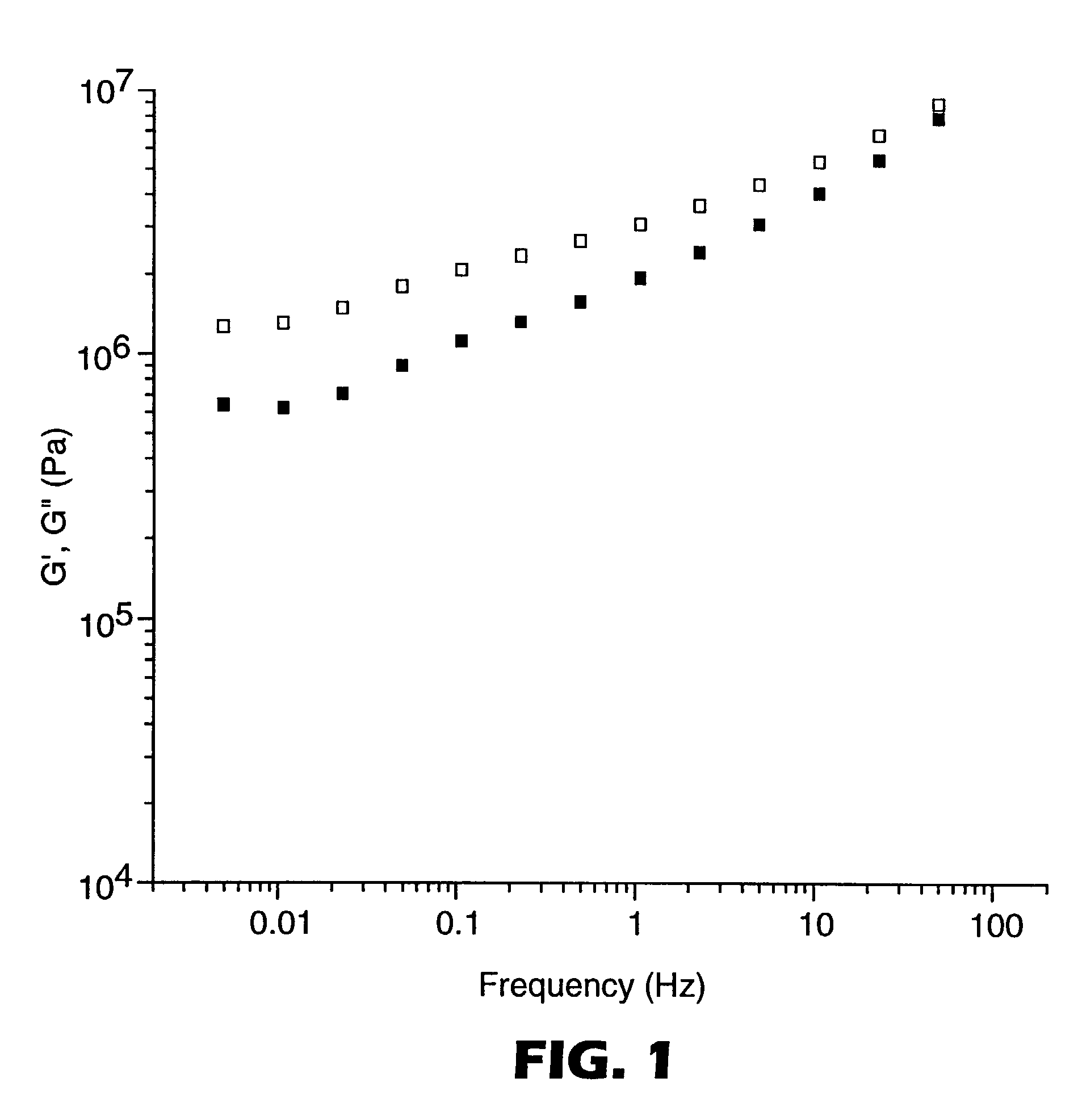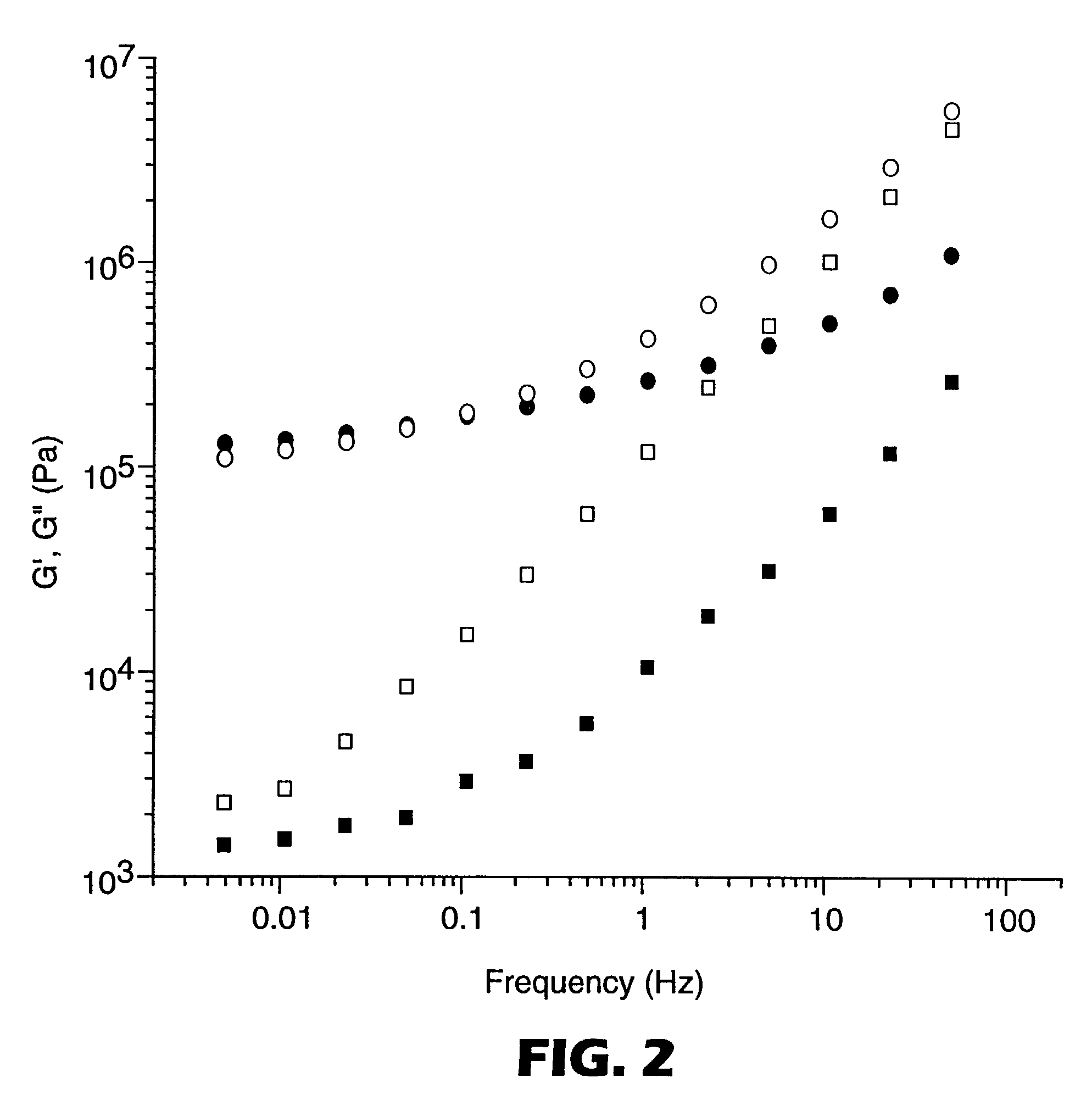Hardenable self-supporting structures and methods
a self-supporting structure and self-supporting technology, applied in the field of materials, can solve the problems of not being suitable for dental prosthetic applications, materials do not possess desirable properties such as compressive strength and wear resistance, and materials have generally poor mechanical properties, so as to enhance the formation of non-covalent structures
- Summary
- Abstract
- Description
- Claims
- Application Information
AI Technical Summary
Benefits of technology
Problems solved by technology
Method used
Image
Examples
examples 16-32
Self-Supporting Light-Curable Composites
[0157]Self-supporting, light-curable composites (Examples 16-32) were prepared according to the procedure described for Examples 1-14 with the ingredient names and quantities for each example shown in Table 2).
[0158]
TABLE 2BisResin AdditiveGMA(Semi-Crystalline)Surfactant-(g)STZPhoto-Ex.(g)(g)Fumed Silica-(g)(g)initiator161.95LEX160-IEM-1.95TPEG-0.1215.13 PI#1**M5-0.468172.93LEX110-IEM-0.98TPEG-O.1215.13PI#1M5-0.468182.7*TONE0230-IEM-0.9ARQ-0.1114.80 PI#2***R972-0.54192.52TONE0230-IEM-1.18TPEG-0.1114.36PI#2R711-0.44202.93THEI(10)-IEM-0.98TPEG-0.1215.21PI#1M5-0.39211.95THEI(5)-IEM-1.95TPEG-0.1215.13PI#1M5-0.468221.99BisGMA(5)-IEM-1.99TPEG-0.1215.72PI#1M5-0.20231.99GGDA(5)-IEM-1.99TPEG-0.1215.72PI#1M5-0.20242.93THEIC-TMA-0.98TPEG-0.1215.13PI#1M5-0.468251.95THEIC-TA-1.95TPEG-0.1215.13PI#1M5-0.468262.93THEIC-TA-0.98TPEG-0.1215.13PI#1M5-0.46827 2.52*CHDM-DMA-1.08TPEG-0.1114.90PI#2M5-0.43228 3.50*NoneTPEG-0.1114.47PI#2M5-0.437529 3.50*NoneTPEG-0.111...
examples 1-14 , 16-32
Examples 1-14, 16-32, and Comparative Example 1
[0159]Composite samples (Examples 1-14, 16-32, and Comparative Example 1) were evaluated for pre-cure elastic and viscous moduli, for pre-cure crown formation, and for post-cure flexural strength, flexural modulus, compressive strength, and diametral tensile strength according to the Test Methods described herein. All samples passed the Pre-Cure Crown Formation Test, except for the Comparative Example 1 sample that was very soft and not self-supporting. Results from the other evaluations are provided in Table 3 (Examples 1-14 and Comparative Example 1) and Table 4 (Examples 16-32).
[0160]
TABLE 3(Numbers in Parentheses are Standard Deviations)G′G″Diametral TensilekPaFlexuralCompressiveStrength,FlexuralEx.(at 0.005 Hz)Strength, MPaStrength, MpaMPaModulus, MPaCE-11.42.3133(21)277(26)44(6)7933(805) 1127108134(15)323(13)42(6)8487(678) 29580115(12)340(19) 52(11)5275(630) 3577350121(12)319(21)44(6)5169(726) 4138120168(13)328(38)42.5(7) 8928(19...
example 15
[0172]The composite sample from Example 15 was evaluated for post-cure flexural strength and flexural modulus according to the Test Method described herein. Following curing the resulting hard, tough material had the following flexural strength and modulus values that were very acceptable for a material to be used as a dental article, e.g., as a dental impression tray. Flexural Strength=66 MPa (Standard Deviation=5) and Flexural Modulus=915 MPa (Standard Deviation=115).
PUM
| Property | Measurement | Unit |
|---|---|---|
| temperature | aaaaa | aaaaa |
| frequency | aaaaa | aaaaa |
| particle size | aaaaa | aaaaa |
Abstract
Description
Claims
Application Information
 Login to View More
Login to View More - R&D
- Intellectual Property
- Life Sciences
- Materials
- Tech Scout
- Unparalleled Data Quality
- Higher Quality Content
- 60% Fewer Hallucinations
Browse by: Latest US Patents, China's latest patents, Technical Efficacy Thesaurus, Application Domain, Technology Topic, Popular Technical Reports.
© 2025 PatSnap. All rights reserved.Legal|Privacy policy|Modern Slavery Act Transparency Statement|Sitemap|About US| Contact US: help@patsnap.com



